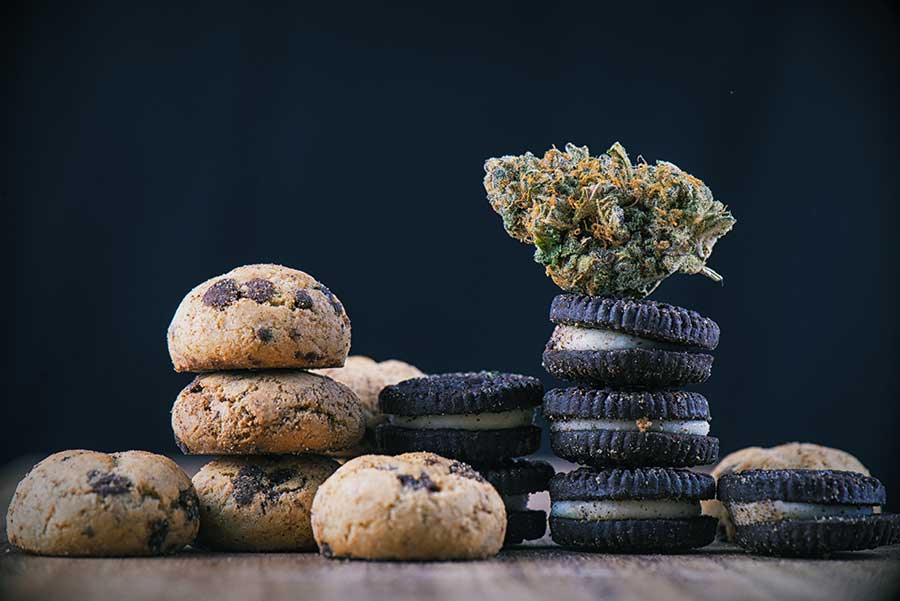A Beginner’s Guide to Creating Edibles
and other Cannabis-infused Foods
What is that overwhelming smell? It is of humankind’s favorite pastimes: edibles. For as long as humans have known about cannabis, we have discovered a multitude of ways to ingest it for medicinal as well as recreational benefits. With the popularity of marijuana continuing to skyrocket, many are taking creating cannabis-infused foods into their own hands and kitchens. This beginner’s guide will serve as a solid foundation for understanding the science behind infused edibles, cannabis cooking oil, decarboxylation, and ultimately how to create delicious and enjoyable edibles.
What Are Edibles?
Edibles are foods that have been infused with cannabis. More specifically, edibles are infused with cannabinoids such as THC and CBD. People and pharmaceutical companies have been creating edibles (and tinctures) since the early 1800s. Cannabinoid-infused tonics were prevalent until the prohibition of the plant. Infused edibles are noted with gaining popularity during the Counterculture era. Commonly, this era is regarded as the ‘Hippie era’ or 1970s. The exploration of infused edibles was at an all-time high widely found in desserts and treats like the timeless ‘not your mother’s brownies.’
How to Make Edibles
Since edibles have become a staple in cannabis culture, canna-chefs have moved from creating simple desserts to five-star gourmet meals. Sweets were often used due to their overwhelming need for lipids and fats. These same lipids and fats, such as butter or cooking oil, are also necessary to create potent infused edibles. This is because compounds such as THC, the cannabinoid responsible for the psychoactive effect found in cannabis, must be activated to be genuinely effective. And that brings us to our next topic, decarboxylation.
What is Decarboxylation?
Decarboxylation is the process of using heat to convert one compound to another. In regards to making infused edibles, the THC must be chemically converted into THCA. The latter, scientifically known as Delta-9 TetraHydrocannabinolic Acid, is the most effective way to make sure your edibles are potent. This process is completed by applying heat to the cannabis flowers via a conventional oven. Despite the intimidating scientific jargon, the process of decarboxylation is quite simple.
How to Decarb Cannabis
To de begin the decarboxylation process, preheat your oven to 220°F. A good rule of thumb when decarbing your cannabis is a simple ratio: 15 minutes per 3.5 grams of dried, minced marijuana. Once you have chosen the amount of cannabis to infuse, place the ground cannabis spaciously on a safe baking dish on top of a sheet of aluminum foil. The oven will provide the appropriate amount of heat to begin the conversion of THC into THCA.
Moreover, THCA is much more potent than THC. Once your amount of cannabis has been heated for the appropriate amount of time, it is ready to be infused into fats or oils. From here, canna-chefs typically infused the decarbed buds into butter or oil. This is how cannabutter and cannabis cooking oil is created, thanks to decarboxylation.
Cannabutter or Cannabis Cooking Oil?
Once you have completed the decarboxylation process, a question may come to a head: ‘Which is better? Cannabutter or Cannabis Cooking Oil?’ The simple answer is neither. Choosing to create cannabutter or cannabis cooking oil for your cannabis-infused foods is reliant on the diner’s dietary preferences. One is not better than the other. This is because the decarbed cannabis will still provide the same amount of potency per the amount of fats or oil used. If you have been trying to wean off butter, then cannabis cooking oil may be for you. If you are interested in a more homestyle taste for your dishes, then cannabutter may be what you are seeking. If the recipe can be combined with butter or oil (virtually any dish), then your guest will be in for quite the medicated experience.

